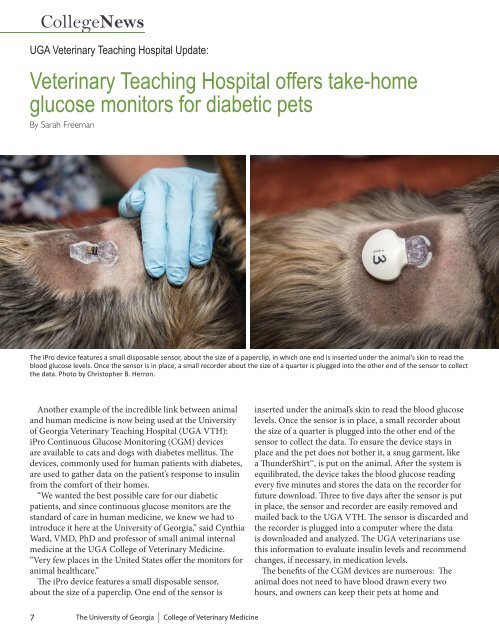Spring/Summer 2013 Aesculapian Magazine - University of Georgia ...
Spring/Summer 2013 Aesculapian Magazine - University of Georgia ...
Spring/Summer 2013 Aesculapian Magazine - University of Georgia ...
You also want an ePaper? Increase the reach of your titles
YUMPU automatically turns print PDFs into web optimized ePapers that Google loves.
CollegeNews<br />
UGA Veterinary Teaching Hospital Update:<br />
Veterinary Teaching Hospital <strong>of</strong>fers take-home<br />
glucose monitors for diabetic pets<br />
By Sarah Freeman<br />
The iPro device features a small disposable sensor, about the size <strong>of</strong> a paperclip, in which one end is inserted under the animal’s skin to read the<br />
blood glucose levels. Once the sensor is in place, a small recorder about the size <strong>of</strong> a quarter is plugged into the other end <strong>of</strong> the sensor to collect<br />
the data. Photo by Christopher B. Herron.<br />
Another example <strong>of</strong> the incredible link between animal<br />
and human medicine is now being used at the <strong>University</strong><br />
<strong>of</strong> <strong>Georgia</strong> Veterinary Teaching Hospital (UGA VTH):<br />
iPro Continuous Glucose Monitoring (CGM) devices<br />
are available to cats and dogs with diabetes mellitus. The<br />
devices, commonly used for human patients with diabetes,<br />
are used to gather data on the patient’s response to insulin<br />
from the comfort <strong>of</strong> their homes.<br />
“We wanted the best possible care for our diabetic<br />
patients, and since continuous glucose monitors are the<br />
standard <strong>of</strong> care in human medicine, we knew we had to<br />
introduce it here at the <strong>University</strong> <strong>of</strong> <strong>Georgia</strong>,” said Cynthia<br />
Ward, VMD, PhD and pr<strong>of</strong>essor <strong>of</strong> small animal internal<br />
medicine at the UGA College <strong>of</strong> Veterinary Medicine.<br />
“Very few places in the United States <strong>of</strong>fer the monitors for<br />
animal healthcare.”<br />
The iPro device features a small disposable sensor,<br />
about the size <strong>of</strong> a paperclip. One end <strong>of</strong> the sensor is<br />
inserted under the animal’s skin to read the blood glucose<br />
levels. Once the sensor is in place, a small recorder about<br />
the size <strong>of</strong> a quarter is plugged into the other end <strong>of</strong> the<br />
sensor to collect the data. To ensure the device stays in<br />
place and the pet does not bother it, a snug garment, like<br />
a ThunderShirt, is put on the animal. After the system is<br />
equilibrated, the device takes the blood glucose reading<br />
every five minutes and stores the data on the recorder for<br />
future download. Three to five days after the sensor is put<br />
in place, the sensor and recorder are easily removed and<br />
mailed back to the UGA VTH. The sensor is discarded and<br />
the recorder is plugged into a computer where the data<br />
is downloaded and analyzed. The UGA veterinarians use<br />
this information to evaluate insulin levels and recommend<br />
changes, if necessary, in medication levels.<br />
The benefits <strong>of</strong> the CGM devices are numerous: The<br />
animal does not need to have blood drawn every two<br />
hours, and owners can keep their pets at home and<br />
7<br />
The <strong>University</strong> <strong>of</strong> <strong>Georgia</strong><br />
College <strong>of</strong> Veterinary Medicine

















